Are Snapping Turtles Dangerous? Unknown Facts!
Throughout history, snapping turtles have long been the subject of myth and legend, often regarded as dangerous and fearsome creatures. But are these reptiles as dangerous as they are made out to be?
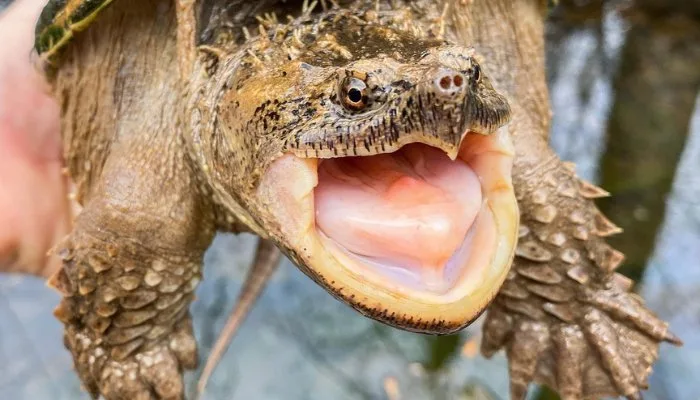
They are known to be dangerous as they can grow very large in size. They can weigh up to 200 pounds and have powerful jaws that can crush anything they hold in their mouth. But despite their dangerous looks, they are not aggressive towards humans. If you encounter a snapping turtle, leave it alone, and it will leave you alone.
Remember that snapping turtles have a powerful beaks and can deliver a nasty bite if they feel threatened. It is important to give snapping turtles their space and not to try to handle them, as they can be quite aggressive when feeling threatened. The dangers of snapping turtles are not just limited to their bite; they are also known to carry salmonella, making it important to always wash your hands thoroughly after coming into contact with them. It’s best to enjoy snapping turtles from a safe distance and appreciate them in their natural habitat.
In this article, we will take a look at some of the most important facts about snapping turtles. We will also discuss the characteristics of these turtles and how to deal with them if you encounter them.
Are Snapping Turtles a Potential Hazard?
Snapping turtles are not generally dangerous. They are large, but they are not aggressive creatures. For the most part, they are usually docile and shy.
But these turtles can be potentially dangerous if they feel threatened. These large reptiles do not attack or defend themselves if threatened. They will just retreat into their shell—closed off from the world—and remain still.
However, if you corner a snapping turtle or provoke it too much, it may bite you. It may even latch on and not let go. So it is best not to mess with these guys.
In the wild, they are typically timid creatures that will stay away from people and won’t engage in any aggression unless they are provoked. As such, it is best to avoid handling them and keep a safe distance if you happen to come across one in the wild.
What Are the Dangers of Handling a Snapping Turtle?
The dangers of handling a snapping turtle should not be underestimated. Although these aquatic reptiles are not as aggressive or as dangerous as some people may think, they can still pose a threat if not handled properly.
Injury from Beaks or Tail
The most common danger of handling these turtles is the bite risk. Snapping turtles have long, powerful jaws that can easily cause a deep puncture wound, which can lead to infection and other complications. These turtle’s jaws are so powerful that they can easily bite through skin and flesh and break bones in their powerful tails.
Inherited Defects
Some of these turtles may be born with a deformed shell or other inherited defect that makes them more likely to bite or scratch a human trying to handle them.
Salmonella or Other Diseases
They can carry salmonella or other diseases that can be transmitted to humans through bites or scratches.
Over-handling or Stress
It’s best to handle a snapping turtle as little as possible and avoid stressing it out. Allowing the turtle to crawl in and out of your hands without grabbing at it can help prevent it from biting or scratching.
How to Deal With a Wild Snapping Turtle?
If you come across a snapping turtle in the wild, there are a few things you can do. First, don’t touch it! Snapping turtles have a strong bite—one that can cause serious injury or even death to humans.
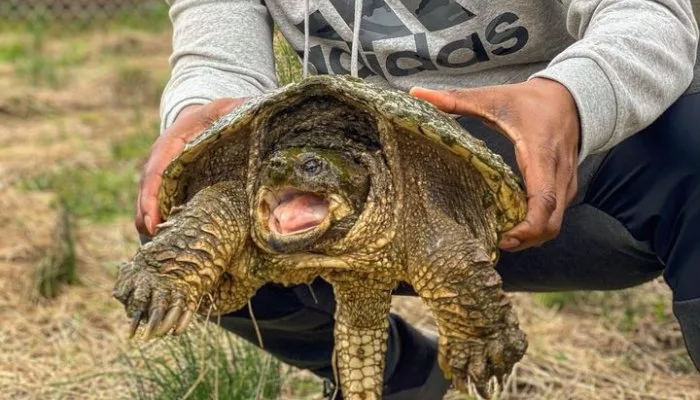
If you’re near water, you can try moving the turtle back into the water. If you can’t get the turtle back in the water, try moving it to a shaded area away from trails and roads. If you can’t move the turtle, call your local wildlife agency for help—don’t try to capture or move it yourself.
If you touch or corner a snapping turtle, it will defend itself by biting or striking with its long claws. So it’s important to make sure you don’t come into contact with the reptile.
Why Are Snapping Turtles So Aggressive?
Snapping turtles are known to be relatively aggressive in comparison to other turtle species. This is due to their large size and ability to frighten predators easily. The most common reasons are explained.
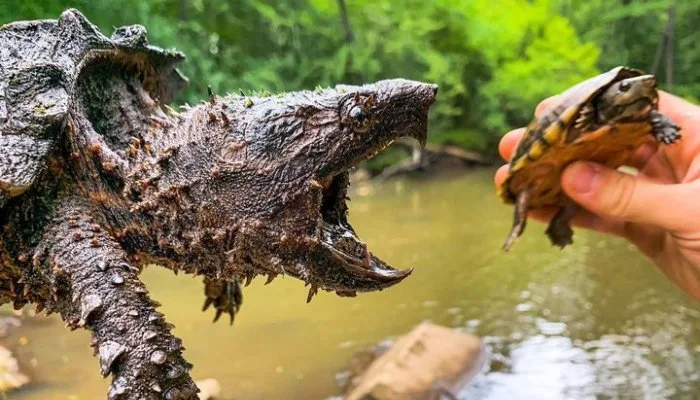
Defensive Activity
Their aggressive behavior also serves as a defense mechanism against potential predators or threats. For example, when threatened, they will often snap their powerful jaws, making a loud noise and creating a large splash in hopes of scaring away their threat.
Severe Physical Pain
They have a hard shell—but they can still be injured. If a turtle’s shell is damaged, it may become aggressive and lash out at anything that comes near it. In addition, a turtle with a damaged shell may suffer from severe physical pain.
Stress
These turtles are often found in bodies of water with low water levels—causing them to become stressed and aggressive. A turtle constantly being picked up and moved by people may also become stressed and lash out.
Poor Handling Technique
When handling this turtle, it is necessary to use the right technique. Poor handling techniques cause them to become aggressive. Grab the turtle’s tail—not its neck. Use two hands to support its body. If the turtle starts to snap, let it go. It is not worth getting hurt to handle a turtle properly.
Predatory Instincts
A snapping turtle is a predator—and may have a natural instinct to hunt and eat other animals. If a turtle is kept as a pet, it may lash out at people or other animals in its tank.
Do Snapping Turtles Bite?
These turtles have powerful jaws and a reputation for being aggressive, so it is natural to wonder if they bite. Well, Yes! They can bite, and their bites can be quite powerful. They have sharp beaks that can easily penetrate flesh, so take the necessary precautions when handling them. It is important to be responsible and cautious when interacting with these turtles to avoid getting bitten. The dangers of turtle bites include the risk of infection from the bacteria in their mouths and potential injury from their powerful jaws. It is always best to consult with a professional and follow safety guidelines when handling these turtles to minimize the risk of getting bitten.
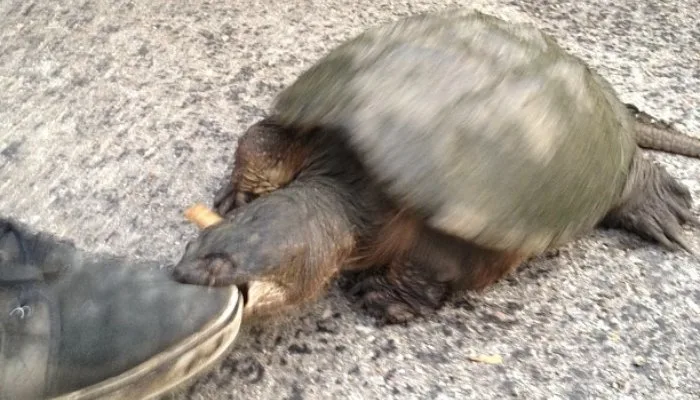
It is also necessary to note that snapping turtles are generally not aggressive and will only bite if they feel threatened or provoked. If you are observing them in the wild, it is important to keep your distance and not disturb them. If you plan on handling them, it is best to wear protective gloves to keep you safe.
Do Snapping Turtles Attack Dogs?
In general, no—snapping turtles will not attack dogs. They are not considered an aggressive species and are usually too slow and non-threatening to be a threat. Therefore, small dogs that get too close to this turtle may be at risk of attack.
If a snapping turtle does decide to attack, it’s important to know that its bite can be very painful and damaging. If a dog is bitten, it’s important to monitor their health and take them to the vet if needed. Sometimes, it may require medical attention and antibiotics to help with the infection.
Now, there are some exceptions to this—such as male snapping turtles during mating season, who may become aggressive and attack anything near them.
How Badly Can a Snapping Turtle Hurt You?
A snapping turtle can hurt you badly—though it’s rare for them to attack a person. If a turtle gets scared or feels threatened, it may clamp down on your hand or arm with its sharp beaks—causing deep lacerations and injuries that may require medical attention.
But don’t be afraid—there are some ways you can keep a snapping turtle away from you if you come across one in the wild or in your backyard.
Keep your distance
The most important thing to remember when encountering a snapping turtle is to keep your distance. Avoid disturbing or approaching a turtle if you see one in the wild. They can be aggressive, but they won’t attack a human if left alone. These turtles can be aggressive and have powerful jaws, so it is best to avoid getting too close. Snapping turtles can be found in a variety of habitats, including freshwater marshes, streams, and ponds. They prefer shallow, slow-moving water with soft bottoms, where they can easily bury themselves in the mud. It is important to respect their natural habitat and observe from a safe distance to avoid any potential conflicts. Understanding and respecting the snapping turtle habitat is crucial for both their safety and ours.
Do not feed them
Feeding a snapping turtle can make them become more accustomed to humans, and they may approach you more frequently, looking for food.
Remove attractants
If you have a pond or other body of water on your property, make sure to remove any potential food sources that might be attracting the turtle. This includes removing fish or other aquatic life and keeping the area around the water clean.
Build a barrier
If a snapping turtle is causing a problem in your backyard, you can build a barrier around your pond or other body of water. A simple fence or wall can be an effective way to keep the turtle away from the area.
Can You Keep a Snapping Turtle as a Pet?
It would be best if you did not keep a snapping turtle as a pet. They are too large and aggressive to be kept in an indoor space, and they require a large pond or lake to live in. They are not recommended as pets for most people. They are wild animals with specific needs that can be difficult to meet in captivity.
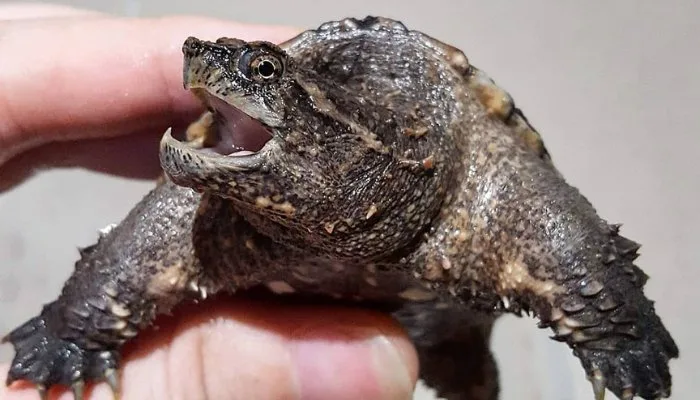
It is illegal to keep wild-caught snapping turtles as pets in many states. Even if it is legal in your area, it is not ethical to take a wild animal from its natural habitat and keep it in captivity. If you do decide to keep this turtle as a pet, it is best to adopt one from a rescue organization or obtain one from a reputable breeder.
They require a large enclosure, as they can grow to be large (up to 35 inches in length). The enclosure should have a large water area, as they are aquatic turtles, and they also require a basking area. They also require a heating and lighting system to mimic the conditions of their natural habitat.
Besides, they can be quite aggressive and can bite, so handle them with caution. They also tend to have a strong odor, which can be difficult to manage. Having this reptile as a pet is not worth the risk—when so many other species make great pets.
Can Alligators Pose a Threat to Snapping Turtles?
Alligators can indeed pose a significant threat to snapping turtles due to the impact of alligator bites on turtle shells. The powerful jaws and sharp teeth of alligators can easily crush and puncture the shell of a snapping turtle, causing severe damage or even death. Snapping turtles rely on their hard shell for protection, but when faced with an alligator attack, their defense mechanism can prove insufficient. Hence, it is crucial for snapping turtles to avoid encounters with alligators in order to ensure their survival.
Do Snapping Turtles Have Teeth and Are They Dangerous?
The snapping turtle’s toothless jaws unveiled may come as a surprise. Despite lacking traditional teeth, they have a sharp beak-like structure that helps them consume prey. Known for their aggressive nature, snapping turtles can be dangerous if provoked. Their powerful jaws and strong bite force make them formidable creatures, so caution is advised when encountering them in the wild.
Conclusion
While snapping turtles may appear intimidating and aggressive, they usually won’t bite unless they feel threatened. Remember that these turtles are wild animals and should be treated with respect.
If you come across this turtle, you should give it a wide berth and leave it alone. And, of course, if you have a pet snapping turtle, always use caution and keep it in a secure enclosure.
So, that’s all we have for you in this article. We hope you found this article helpful regarding the characteristics of these turtles. If you ever find yourself in a situation where a snapping turtle is attacking you, try to defend yourself with any weapon you may have.

